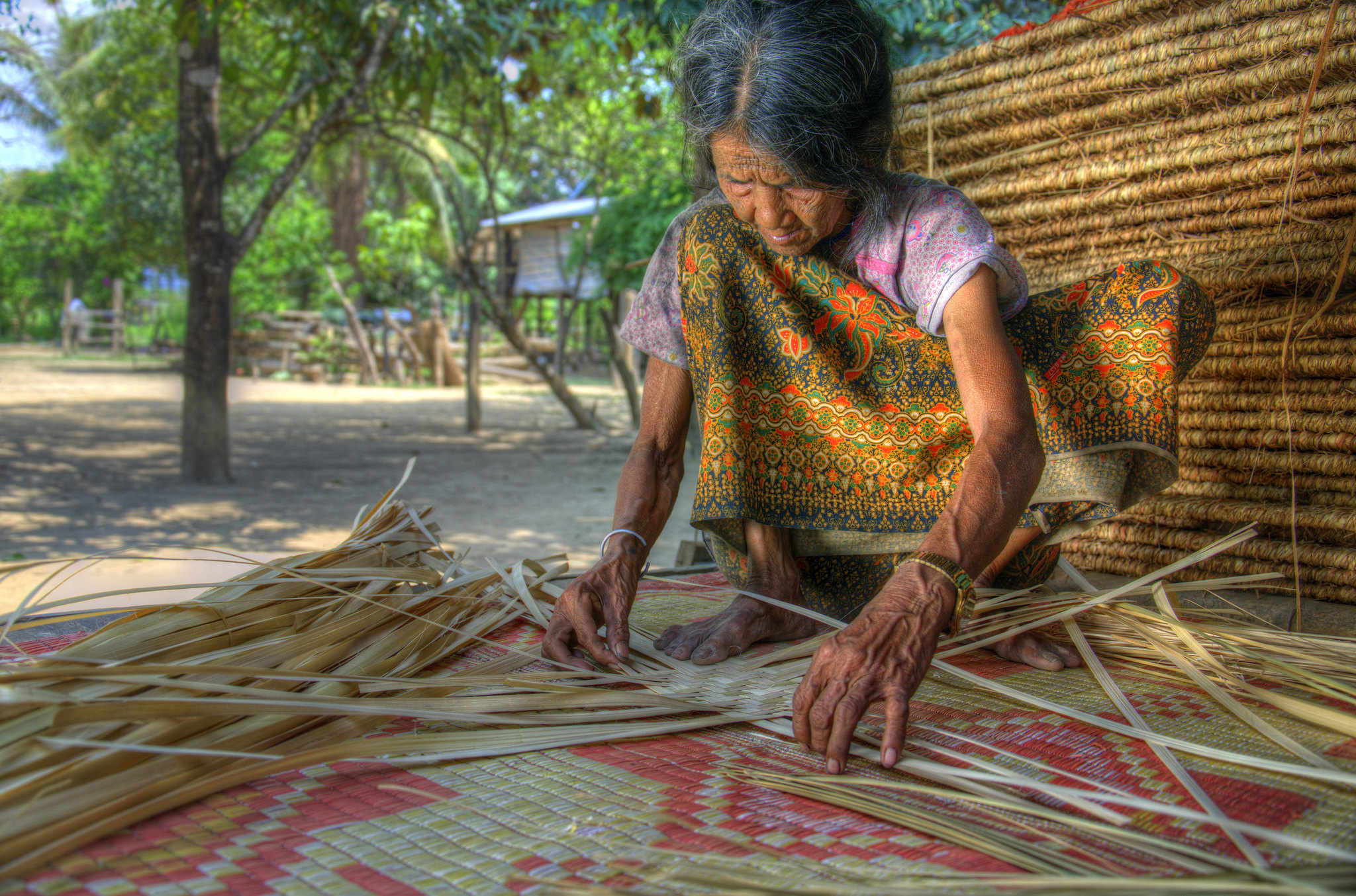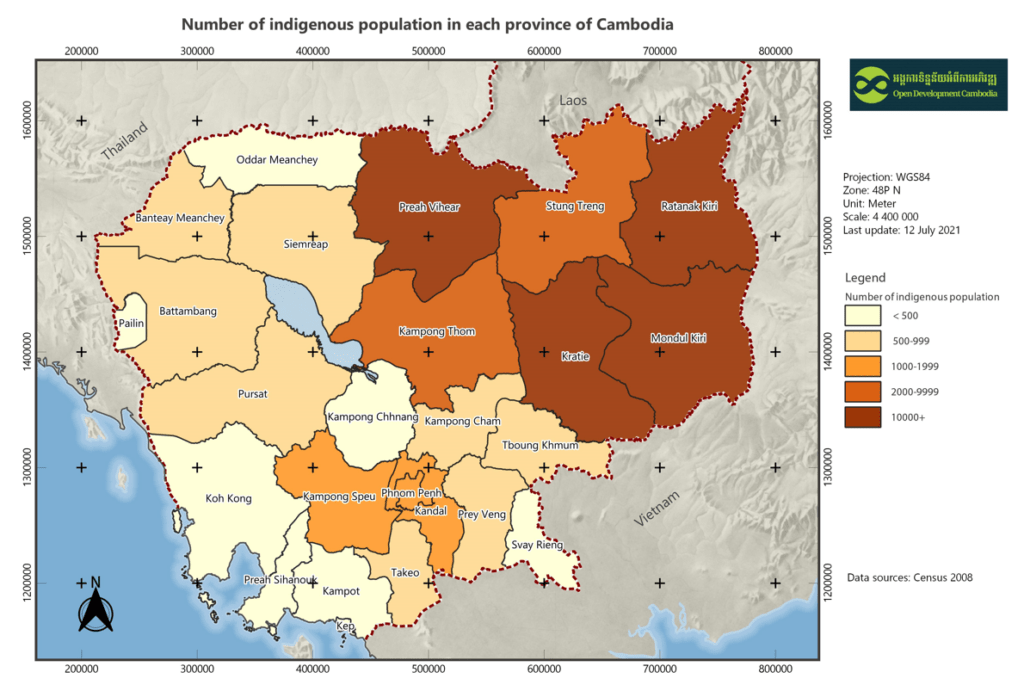According to the Kingdom of Cambodia’s 2019 general population census, the total Cambodian population is 15,552,211 (51.31% of females).1 By 2021, the population increased to 16,589,023.2 Vietnamese, Chinese, Chams and other minorities also live in the country. Indigenous ethnic groups known as “Khmer Loeu” live in Cambodia, and they are granted some lands from the government, including communal land titles, as stated in Sub-Decree No. 83 on the procedures for registering indigenous communities’ land.3
Policy on the development of indigenous people provides the definition, “Indigenous peoples are the peoples living in the Kingdom of Cambodia, and they express their ethnic, social, cultural, and economic unity, practice their traditional way of life, and cultivate the land they occupy according to the traditional rules of collective land use.”4

Ethnic Broa woman weaving a mat from palm fronds in Ratanakiri, Northeast Cambodia. Photo by Ethan Crowley, taken on 01 May 2012. Licensed under CC BY-NC-SA 2.0
Indigenous population
The 1998 Cambodian population census identified 17 different indigenous peoples spread across 15 provinces. They are estimated to number around 200,000 or around 1.2% of the population.5 Groups are often identified by their language. There are at least 21 indigenous languages in Cambodia.6
The 2008 Cambodian population census identified 22 different indigenous people, consisting of 179,193 people.7 The indigenous population increased to 183,831 people in 2013. In 2014, the commune database identified 252,337 indigenous people in Cambodia, and the socioeconomic observation data illustrated 243,357 indigenous people in 2015.8 However, according to Cambodia Indigenous Peoples Organization (CIPO), the total indigenous population of 276,878, with classified by each group, Kouy indigenous group has the majority of the population consisting of 20.12% living in 135 villages across Cambodia.9 The 22 indigenous group includes Bunong, Kouy, Stieng, Mil, Kroal, Thmorn, Khaonh, Tompuonn, Charay, Kroeung, Kavet, Saouch, Lun, Kachak, Praov, Raadear, Chorng, Por, Souy, Chaong, Lmoun, and Mon.10
Location of indigenous peoples
Indigenous peoples are found in 22 provinces throughout Cambodia, with the majority of them concentrated in the northern and northeast parts, including Ratanakiri, Mondulkiri, Kratie, Preah Vihear, and Stung Treng provinces. The spread of indigenous peoples could be attributed to occupation, education, marriages, and other factors.11 The long-term well-being of indigenous cultures is strongly linked to their land use systems and access to forest resources. They practice rotational (shifting) cultivation and animal husbandry, and in forests, harvest rattan and vine, resin, cardamom, and honey. Weaving is another key source of income. Some income sources depend on location, such as zircon gemstone mining outside Banlung in Ratanakiri.

The number of the indigenous population in each province of Cambodia (Based on statistics in 2008).
Laws and policies
The Ministry for Rural Development has a National Policy on the Development of Indigenous Peoples (NPDIP), approved in 2009.12 The NPDIP aims to promote the livelihoods of indigenous peoples and to improve their quality of life. It concentrates on ten development sectors, including culture, education and vocational training, health, environment, land, agriculture and water resources, infrastructure, justice, tourism, industry, mines, and energy.
The 2001 Land Law makes crucial provisions for communal land titles in articles 23–28. Article 25 provides for collective ownership of land, while Article 26 recognizes the role of traditional authorities, mechanisms, and customs in decision-making and exercising ownership rights. Under Article 28, no authority outside the community may acquire any rights to immovable properties belonging to an indigenous community.
A sub-decree on procedures of registration of land of indigenous communities was approved in June 2009, but progress has been slow because of the complexity of the process:
- The Ministry of Rural Development must first recognize the identification of an indigenous people and community
- The Ministry of Interior must then register the community as a legal entity
- The Ministry of Land Management, Urban Planning and Construction then carries out a collective land titling procedure. This involves surveying the property, making the proposal open for public comments, and issuing the title.
While the Land Law gives strong protection on paper for indigenous communities, many observers have said that the lack of implementation and enforcement has left indigenous peoples vulnerable to commercial and state interests, which are increasingly attracted to exploiting the economic potential of the forests and upland areas traditionally used and managed by indigenous communities.13
By 2022, 152 indigenous communities have registered with the Ministry of Interior (MoI) as legal entities, and 94 have requested communal land titles from the Ministry of Land Management, Urban Planning and Construction (MLMUPC). 26 of these communities were suspended due to various challenges and encounters. 38 indigenous communities in four provinces have received communal land titles totaling 39,342 hectares: Stung Treng (02 communities), Kratie (04 communities), Mondulkiri (07 communities), and Ratanakiri (25 communities).14
The 2002 Forestry Law addresses customary user rights of forest products and by-products for local communities15 and provides a legal basis for rural communities, including indigenous communities, to use and help manage forests through community forestry. While the Forest Law provides a legal basis for community forests, the 2003 Sub-decree no. 79 on Community Forest Management set out rules for establishing, managing, and using these forests in Cambodia.
Challenges and issues regarding land rights
Indigenous people face significant challenges when it comes to securing land rights and resolving land disputes. These challenges include:
- Land grabbing and encroachment: Indigenous communities are often subject to land grabbing by outside interests. This can lead to displacement, loss of livelihoods, and erosion of cultural traditions.16
- Weak legal protections: Although indigenous peoples' land rights are legally protected in Cambodia's Constitution and Land Law, these protections are frequently weakly enforced, and indigenous communities have little recourse when their rights are violated.17
- Lack of consultation and participation: Indigenous communities in Cambodia are frequently excluded from land management and development decision-making processes. This can lead to land disputes and conflict and a breakdown in trust between indigenous communities and government or corporate entities.18
Related to Ethnic minorities and indigenous people
- Land
- Communal land
- Development and assistance for ethnic minorities and indigenous people
- Ethnic minorities and indigenous people associations
- Ethnic minorities and indigenous people development funding
- Ethnic minorities and indigenous people development NGOs
- Ethnic minorities and indigenous people policy and rights
- Ethnic minorities and indigenous people profiles
Last update was on 03 March 2023.
References
- 1. National Institute of Statistics, “General population census of the Kingdom of Cambodia 2019: National Report on final census results,” Ministry of Planning, October 2020, accessed on 27 February 2023.
- 2. The World Bank, “Population, total – Cambodia,” accessed on 27 February 2023.
- 3. Office of the Prime Minister, “Sub-Decree No. 83 on procedures of registration of land of indigenous communities,” 09 June 2009, accessed on 27 February 2023.
- 4. Ministry of Rural Development, “Policy on development of indigenous people,” 24 April 2009, accessed on 27 February 2023.
- 5. Moul Phath, Seng Sovathana, “Country technical note on indigenous peoples issues: Kingdom of Cambodia,” IFAD/AIPP, November 2012, accessed 03 March 2023.
- 6. Ethnologue, “Cambodia,” accessed on 03 March 2023.
- 7. National Institute of Statistics, “General population census of the Kingdom of Cambodia 2008: National Report on final census results,” Ministry of Planning, accessed on 27 February 2023.
- 8. Ministry of Planning, “National Report on Demographic and Socio-economic Situation of Indigenous Peoples in Cambodia,” 2021, accessed on 27 February 2023.
- 9. Cambodia Indigenous Peoples Organization, “Indigenous people data,” accessed on 27 February 2023.
- 10. Ministry of Planning, “National Report on Demographic and Socio-economic Situation of Indigenous Peoples in Cambodia,” 2021, accessed on 27 February 2023.
- 11. Ministry of Planning, “National Report on Demographic and Socio-economic Situation of Indigenous Peoples in Cambodia,” 2021, accessed on 27 February 2023.
- 12. Ministry of Rural Development (MRD). “National Policy on the Development of Indigenous Peoples (NPDIP),” 2009, accessed on 03 March 2023.
- 13. Moul Phath, Seng Sovathana, "Country technical note on indigenous peoples issues: Kingdom of Cambodia," IFAD/AIPP, November 2012, accessed 03 March 2023.
- 14. Open Development Cambodia, “Blog: The second cluster convention,” 27 December 2022, accessed on 27 February 2023.
- 15. The Royal Government of Cambodia, “Law on Forestry (2002),” Article 2, 2002, accessed on 03 March 2023.
- 16. Bunly Soeung, “Campaigns, criminalization and concessions: indigenous land rights in Cambodia,” new mandala, 11 August 2022, accessed on 27 February 2023.
- 17. Sarah Johnson, “Illegal logging threatens Cambodia’s indigenous people, says Amnesty,” The Guardian, 28 Jan 2022, accessed on 27 February 2023.
- 18. IWGIA, “Indigenous world 2019: Cambodia,” 24 April 2019, accessed on 27 February 2023.

